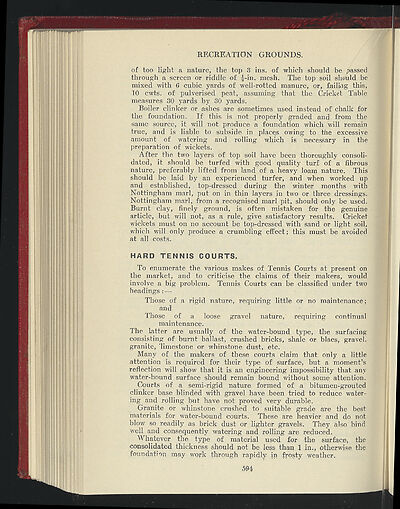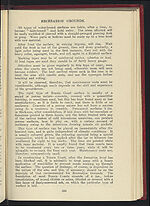1936-37
(620)
Download files
Complete book:
Individual page:
Thumbnail gallery: Grid view | List view

RECREATION GROUNDS.
of too light a nature, the top 3 ins. of which should be passed
through a screen or riddle of
2
-in. mesh. The top soil should be
mixed with 6 cubic yards of well-rotted manure, or, faili<zig this,
10 cwts. of pulverised peat, assuming that the Cricket Table
measures 30 yards by 30 yards.
Boiler clinker or ashes are sometimes used instead of chalk for
the foundation. If this is not properly graded and from the
same source, it will not produce a foundation which
will
remain
true, and is liable to subside in places owing to the excessive
amount of watering and rolling which is necessary in the
preparation of wickets.
After the two layers of top soil have been thoroughly consoli-
dated, it should be turfed with good quality turf of a fibrous
nature, preferably lifted from land of a heavy loam nature. This
should be laid by an experienced turfer, and when worked up
and established, top-dressed during the winter months with
Nottingham marl, put on in thin layers in two or three dressings.
Nottingham marl, from a recognised marl pit, should only be used.
Burnt clay, finely ground, is often mistaken for the genuine
article, but will not, as a rule, give satisfactory results. Cricket
wickets must on no account be top-dressed with sand or light soil.
which will only produce a crumbling effect; this must be avoided
at all costs.
HARD TENNIS COURTS.
To enumerate the various makes of 'tennis Courts at present on
the market, and to criticise the claims of their makers, would
involve a big problem. Tennis Courts can be classified under two
headings:—
Those of a rigid nature, requiring little or no maintenance;
and
Those of a loose gravel nature, requiring continual
maintenance.
The latter are usually of the water-bound type, the surfacing
consisting of burnt ballast, crushed bricks, shale or blaes, gravel.
granite, 'limestone or whinstone dust, etc.
Many of the makers of these courts claim that only a little
attention is required for their type of surface, but a moment's
reflection will show that it is an engineering impossibility that any
water-bound surface should remain bound without some attention.
Courts of a semi-rigid nature formed of a bitumen-grouted
clinker base blinded with gravel have been tried to reduce water-
ing and rolling but have not proved very durable.
Granite or whin-stone crushed to suitable grade are the best
materials for water-bound courts. These are heavier and do not
blow so readily as brick dust or lighter gravels. They also bind
well and consequently watering and rolling are reduced.
Whatever the type of material used for the surface, the
consolidated thickness should not be
less
than 1 in., otherwise the
foundation may work through rapidly
in
frosty weather.
S94
of too light a nature, the top 3 ins. of which should be passed
through a screen or riddle of
2
-in. mesh. The top soil should be
mixed with 6 cubic yards of well-rotted manure, or, faili<zig this,
10 cwts. of pulverised peat, assuming that the Cricket Table
measures 30 yards by 30 yards.
Boiler clinker or ashes are sometimes used instead of chalk for
the foundation. If this is not properly graded and from the
same source, it will not produce a foundation which
will
remain
true, and is liable to subside in places owing to the excessive
amount of watering and rolling which is necessary in the
preparation of wickets.
After the two layers of top soil have been thoroughly consoli-
dated, it should be turfed with good quality turf of a fibrous
nature, preferably lifted from land of a heavy loam nature. This
should be laid by an experienced turfer, and when worked up
and established, top-dressed during the winter months with
Nottingham marl, put on in thin layers in two or three dressings.
Nottingham marl, from a recognised marl pit, should only be used.
Burnt clay, finely ground, is often mistaken for the genuine
article, but will not, as a rule, give satisfactory results. Cricket
wickets must on no account be top-dressed with sand or light soil.
which will only produce a crumbling effect; this must be avoided
at all costs.
HARD TENNIS COURTS.
To enumerate the various makes of 'tennis Courts at present on
the market, and to criticise the claims of their makers, would
involve a big problem. Tennis Courts can be classified under two
headings:—
Those of a rigid nature, requiring little or no maintenance;
and
Those of a loose gravel nature, requiring continual
maintenance.
The latter are usually of the water-bound type, the surfacing
consisting of burnt ballast, crushed bricks, shale or blaes, gravel.
granite, 'limestone or whinstone dust, etc.
Many of the makers of these courts claim that only a little
attention is required for their type of surface, but a moment's
reflection will show that it is an engineering impossibility that any
water-bound surface should remain bound without some attention.
Courts of a semi-rigid nature formed of a bitumen-grouted
clinker base blinded with gravel have been tried to reduce water-
ing and rolling but have not proved very durable.
Granite or whin-stone crushed to suitable grade are the best
materials for water-bound courts. These are heavier and do not
blow so readily as brick dust or lighter gravels. They also bind
well and consequently watering and rolling are reduced.
Whatever the type of material used for the surface, the
consolidated thickness should not be
less
than 1 in., otherwise the
foundation may work through rapidly
in
frosty weather.
S94
Set display mode to:
![]() Universal Viewer |
Universal Viewer | ![]() Mirador |
Large image | Transcription
Mirador |
Large image | Transcription
| Games and sports in the army > 1936-37 > (620) |
|---|
| Permanent URL | https://digital.nls.uk/248725998 |
|---|
| Description | 'Games and Sports in the Army' was an annual publication produced by the British War Office between the 1930s and 1960s. This included the Second World War. It outlines the rules and regulations for games and sports played by members of the armed forces. It features names and photographs of team members, and examples of contemporary advertising. |
|---|---|
| Shelfmark | GWB.52 |

